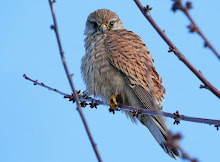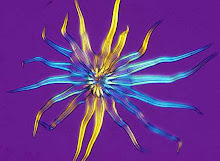We found this dead salmon, on Christmas Eve, in Waskerley beck, a tributory of the river Wear at Wolsingham in Weardale. It had evidently swum upriver from the sea to spawn in shallow gravels and died of exhaustion, old age or disease - or perhaps from all three causes. Patches of fungal disease are clearly evident on its scales. Few salmon make it back to sea after they have spawned.
Monday, December 30, 2024
The end of an epic journey
Tuesday, November 5, 2024
Pale tussock moth caterpillar Calliteara pudibunda
We found this larva of a pale tussock moth crawling along the parapet of Prebends bridge, across the river Wear, in Durham.
Everything about it
warned ‘don’t touch me’. It would present a challenge for most
insectivorous birds, although cuckoos, with a gizzard that can cope with
irritating hairs, sometimes eat them. Those deterrents inflict discomfort on
tender human flesh too; finely barbed and filled with irritating fluid, they
can cause dermatitis. Calliteara pudibunda was once a notorious pest of hop
fields, which might explain naturalist Gilbert White’s journal entry for
October 8th. 1781, noting that ‘ …women and children have eruptions
on their hands ….after they have been employed in hop picking’. More
recently, families from London’s East End, travelling to Kent for traditional
hop picking work every autumn, would have been painfully familiar with these caterpillars, that they knew as ‘hop dogs’.
Pale tussock larvae are not picky about food plants and defoliate at least a dozen broadleaved tree
species, including beech, hawthorn, sycamore and lime, all well represented
along this riverbank. But, out of curiosity, I offered our captive some young
shoots from the hop vine that twines through our garden fence. It had a nibble
but was fully fed and only interested in finding somewhere dry and secure
amongst the leaf litter, where it will pupate inside a cocoon woven from
recycled defensive bristles.
Hatched from an egg
laid last June, this wanderer - provided it hasn’t already been parasitised by
an ichneumon wasp - should survive winter, metamorphosing as a beautiful pale
grey moth next spring.
Monday, July 15, 2024
Ants in the compost bin
We've been composting garden and kitchen vegetable waste in 'Dalek' bins like this for decades, but this year was the first times that we've had one taken over by nesting black ants.
Their larvae are translucent, but as they pupate they spin a silken coat.
Thursday, July 4, 2024
Orange-sided comb-horn - a colourful daddy-long-legs
The two commonest craneflies - Tipula oleracea and T. paludosa - are dull-coloured insects but this female orange-sided comb-horn Ctenophora pectinicornis has an orange and black colour scheme that gives it a hint of menace. We found it in old deciduous woodland on the bank of the river Wear in Durham city. The larvae (leatherjackets) of the two commonest craneflies feed on grass roots in pastures but the larvae of this woodland species feed on decaying fallen timber.
As is so often the case, this specimen has lost a limb. Easily shed limbs might well be a last resort escape strategy, from the beak of a bird or the web of a spider.
Saturday, June 15, 2024
Ox-eye daisy abundance
I often whizz past, at 60 mph, motorway embankments that are covered with flowering ox-eye daisies, but it's not so often that I get a close look at these wild flowers in such abundance beside a footpath. This fabulous display covers an embankment in Hexham in Northumberland, on edge land between the railway line and a retail park road. It is absolutely stunning.
Thursday, June 13, 2024
Curlews
These anxious curlews accompanied me on part of a walk in the Deerness valley, County Durham last week. They must have recently hatched young because they were highly agitated, with those yelping calls that they make when anything threatens their nest site.
The weather is cold, wet and windy and they have crow predators to see off. They are nesting fields that I hope will be cut for hay, rather than mown early for silage. I've seen curlews raise successful broods in the same place in previous years, so fingers crossed.
Friday, June 7, 2024
Dung beetle aka dumbledor aka dor beetle aka lousy watchman
Some more pictures of the dung beetle described in today's Guardian Country Diary
' Deerness Valley, County Durham
Waiting for the clip-clop of hooves to fade away, using a
polythene bag as a glove, I picked up a tennis ball-sized, steaming lump of
horse manure. Checking that no one else was around – this kind of old-school
natural history might seem a tad eccentric to a casual passer-by – I hurried
home: I had dung beetles to feed.
I’d found them on the edge of a pasture and, coincidentally,
had recently been reading The Sacred Beetle, Jean-Henri Fabre’s century-old
account of the breeding biology of scarabs, including our native species. Could
I witness what the great French naturalist first described in such fascinating
detail? Fabre, meticulous observer, curious experimentalist, cautious
interpreter of facts, spent years studying these ‘dealers in ordure’ whose coprophilous
habits make them an agricultural asset. One study has estimated their value to
the UK cattle industry, as soil improvers and recyclers of dung, at £367m per
annum.
My captive Geotrupes stercorarius, also commonly known as dor
beetles, dumbledores or lousy watchmen (they often host parasitic mites), fell
out of the collecting tube onto their backs, revealing beautifully iridescent
amethyst-violet undersides.
They have endearing parenting skills; Fabre discovered that both
sexes share in tunnelling and nest preparation. They clambered over the ball of
dung in the vivarium, pausing to saviour it before dropping into the grass,
then digging with flattened fore-legs, forcing themselves into the soil with
powerful thrusts of spiny hind limbs. Clumsy on the surface, they’re superbly
equipped for subterranean life. Within a minute they had disappeared.
Fabre’s account describes how they dig downwards, excavate
side-tunnels provisioned with what he called ‘sausages’ of ordure dragged down
from the surface, then the female lays an egg in each. The next generation should
emerge in autumn.
‘The mind, wrote Fabre, ‘is an activity, not a repository’. In
some respects, naturalists live in a golden age, with so many resources available
for identifying and naming what we find – AI, web sites, apps, on-line keys,
social media study groups – but there’s more to natural history than compiling
an inventory of biodiversity. Nothing comes close to that pleasure, first
experienced in childhood, of first-hand observation, marvelling at lives of
other creatures that share our planet. '
Tuesday, May 28, 2024
Birch sawfly
At first glance I thought this was a bee, resting on a gorse flower - then I noticed those club-tipped antennae, the un-beelike way it held its wings and its lethargic behaviour. It's a dark birch sawfly Trichiosoma lucorum, one of the club-horned sawflies. Its larvae feed on birch leaves.
Sunday, May 26, 2024
Waiting for a breeze
The final phase in the dandelion life cycle, when the flowers are transformed into silvery spheres, dandelion ‘clocks’ composed of seeds each equipped with its own parachute, is a magical moment when an umbrella of hairs, a pappus in botanical parlance, carries the seed up and away on the wind, to pastures new. At sunrise in late spring, whole fields can shimmer with silvery dandelion clocks as their pappuses expand as they dry in the sun’s heat. Sometimes goldfinches arrive to feed on the seeds, releasing wraiths of downy seeds, ethereal ‘witches’ gowns’, into the rising thermals.
The name dandelion
is a corruption of the French dent-de-lion, lion’s teeth, describing the deeply
serrated leaf edges, but botanist Geoffrey Grigson also collected 52 parochial
county names. Some, like Devil’s Milk-plant (Kirkudbrightshire), refer to the
bitter milky sap. Many, like Schoolboys’ Clock and Tell Time (both Somerset)
allude to the childhood game of guessing the time by the number of puffs needed
to blow away all its seeds from the ‘clock’. Monk’s head (Wiltshire), likening
the bare seed head left behind to a monk’s bald pate, is said to have medieval
origins, while Wishes (Wiltshire) stems from the belief that the airborne seeds
carry away hopes and dreams with them.
And perhaps this is the best name of all, for these troubled times. Pick a dandelion clock, rediscover your inner child, blow as hard as you can and send dandelion seeds skywards, into the blue.
Monday, May 13, 2024
Cherry-plum, infected with pocket plum disease
Friday, May 10, 2024
Tawny mining bee
I encountered this lovely little female tawny mining bee Andrena fulva, provisioning her newly-excavated nest tunnel with pollen, on the Teesdale Way footpath between Egglestone and Meeting of the Waters. The lower three images are of what I think is a male of the same species, photographed in my own garden in County Durham, where tawny mining bees are excellent pollinators of blackcurrants.
Monday, May 6, 2024
Brittle bladder-fern
Brittle bladder-fern Cystopteris fragilis in a shady, damp retaining wall in Teesdale, North Pennines. A beautiful, delicate fern with brittle frond stalks, typically found in crevices in limestone and mortared walls in the northern dales. Growing with hart’s-tongue fern in the third picture.





.jpg)




































































